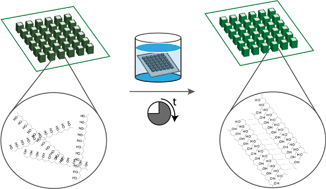We develop three independent non-cryogenic techniques for the production of physical hydrogels based on poly(vinyl alcohol), PVA, as surface adhered materials. Hydrogelation of the micro-structured PVA films was achieved using a coagulating salt (sodium sulfate), aqueous isopropanol, and poly(ethylene glycol), and each of the methods afforded robust hydrogels which remained stable under physiological conditions for at least 48 h. The choice of the stabilization method and polymer molecular weight was decisive in controlling hydrogel dimensions (swelling) and Young's modulus, the latter varied from 20 to 2000 kPa. Immobilization and retention of model low molecular weight cargo were monitored using a custom-made PVA with terminal amine groups, conjugating a fluorescent probe to this polymer and co-gelation of the conjugate with matrix forming PVA. Polymer losses during stabilization and kinetics of cargo release in PBS over time differed depending on the hydrogel stabilization method employed making the latter an effective tool in the design of intelligent biointerfaces. For each stabilization method, we demonstrate retention of model protein cargo over at least 48 h of incubation in physiological buffer, a phenomenon which was used to render the non-adhesive pristine PVA gels well suited for cell adhesion and proliferation. Taken together, we present a flexible and highly adaptable platform for the design of intelligent biointerfaces towards their use in tissue engineering and surface mediated drug delivery.

You have access to this article
 Please wait while we load your content...
Something went wrong. Try again?
Please wait while we load your content...
Something went wrong. Try again?


 Please wait while we load your content...
Please wait while we load your content...